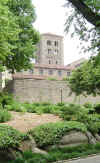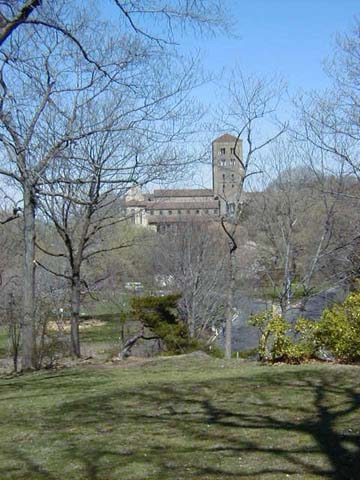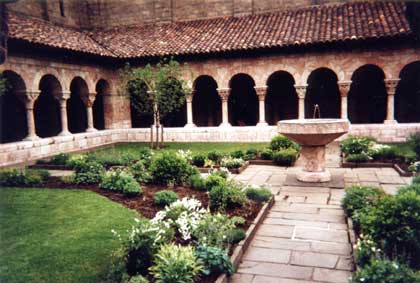 |
New York Architecture Images-Harlem and the Heights The Cloisters |
|
architect |
Charles Collens (1873–1956) |
|
location |
northern Manhattan's Fort Tryon Park |
|
date |
1938 |
|
style |
medieval French cloisters |
|
construction |
stone |
|
type |
Museum |
|
images |
 |
  |
|
 |
|
|
The Cloisters—described by Germain Bazin,
former director of the Musée du Louvre in Paris, as "the crowning
achievement of American museology"—is the branch of the Metropolitan
Museum devoted to the art and architecture of medieval Europe. Located
on four acres overlooking the Hudson River in northern Manhattan's Fort
Tryon Park, the building incorporates elements from five medieval French
cloisters—quadrangles enclosed by a roofed or vaulted passageway, or
arcade—and from other monastic sites in southern France. Three of the
cloisters reconstructed at the branch museum feature gardens planted
according to horticultural information found in medieval treatises and
poetry, garden documents and herbals, and medieval works of art, such as
tapestries, stained-glass windows, and column capitals. Approximately
five thousand works of art from medieval Europe, dating from about A.D.
800 with particular emphasis on the twelfth through fifteenth century,
are exhibited in this unique and sympathetic context.
The collection at The Cloisters is complemented by more than six thousand objects exhibited in several galleries on the first floor of the Museum's main building on Fifth Avenue. A single curatorial department oversees medieval holdings at both locations. The collection at the main building displays a somewhat broader geographical and temporal range, while the focus at The Cloisters is on the Romanesque and Gothic periods. Renowned for its architectural sculpture, The Cloisters also rewards visitors with exquisite illuminated manuscripts, stained glass, metalwork, enamels, ivories, and tapestries. Fifty highlights from the collection housed at The Cloisters are presented online, organized first by culture and, within cultures, chronologically. See Medieval Art for fifty more highlights from the department. Consult Programs at The Cloisters for information about upcoming events at The Cloisters or Visiting The Cloisters to get directions and group reservation information. More about the Department and Its
Collection Much of the sculpture at The Cloisters was acquired by George Grey Barnard (1863–1938), a prominent American sculptor and avid collector of medieval art. While working in rural France before World War I, Barnard supplemented his income by locating and selling medieval sculpture and architectural fragments that had made their way into the hands of local landowners over several centuries of political and religious upheaval. He kept many pieces for himself and, upon returning to the United States, opened to the public a churchlike brick structure on Fort Washington Avenue filled with his collection—the first installation of medieval art of its kind in America. Through the generosity of the philanthropist and collector John D. Rockefeller, Jr. (1874–1960), the museum and all of its contents were acquired by the Museum in 1925. By 1927, it was clear that a new, larger building would be needed to display the collection in a more scholarly fashion. In addition to financing the conversion of 66.5 acres of land just north of Barnard's museum into a public park—inside which the new museum building would be located—and donating seven hundred acres of additional land to the state of New Jersey across the Hudson River to ensure that the view from The Cloisters remain unsullied, Rockefeller contributed medieval works of art from his own collection (including the celebrated set of seven South Netherlandish tapestries depicting "The Hunt of the Unicorn") and established an endowment for operations and future acquisitions. The new museum building was designed by Charles Collens (1873–1956), the architect of New York City's Riverside Church, in a simplified, paraphrased medieval style, incorporating and reconstructing the cloister elements salvaged by Barnard. Joseph Breck (1885–1933), a curator of decorative arts and assistant director of the Metropolitan, and James J. Rorimer (1905–1966), who would later be named director, were primarily responsible for the interior. Balancing Collens's interpretation with strict attention to historical accuracy, Breck and Rorimer created in the galleries a clear and logical flow from the Romanesque (ca. 1000–ca. 1150) through the Gothic period (ca. 1150–1520). The Cloisters was formally dedicated on May 10, 1938. The Treasury, containing sumptuous objects created for liturgical celebrations, personal devotions, and secular uses, was renovated in 1988. The galleries in which the seven tapestries depicting "The Hunt of the Unicorn" are hung were refurbished in 1999. The collection at The Cloisters continues to grow, thanks to Rockefeller's endowment and other significant gifts. Among its masterpieces are an early-fifteenth-century French illuminated book of hours, Les Belles Heures de Jean, Duc de Berry; a richly carved twelfth-century ivory cross attributed to the English abbey of Bury Saint Edmunds; stained-glass windows from the castle chapel at Ebreichsdorf, Austria; a stone Virgin of the mid-thirteenth century from the choir screen of Strasbourg Cathedral in France; and the so-called Merode Triptych, representing the Annunciation, by the fifteenth-century Netherlandish master Robert Campin. |
|
|
links |
|